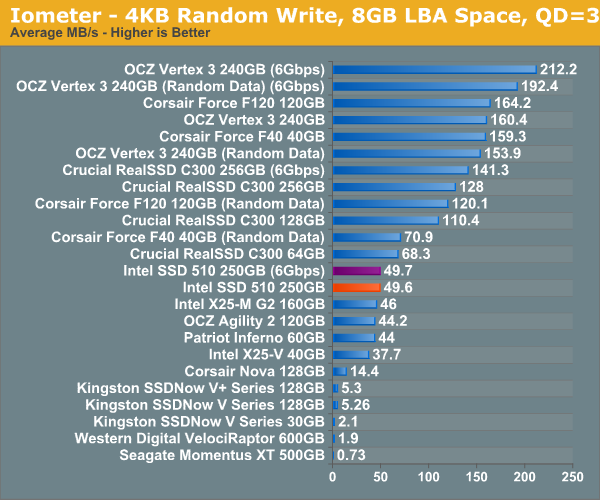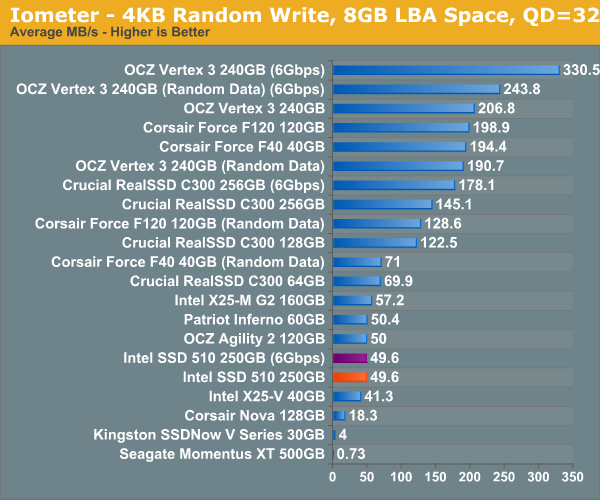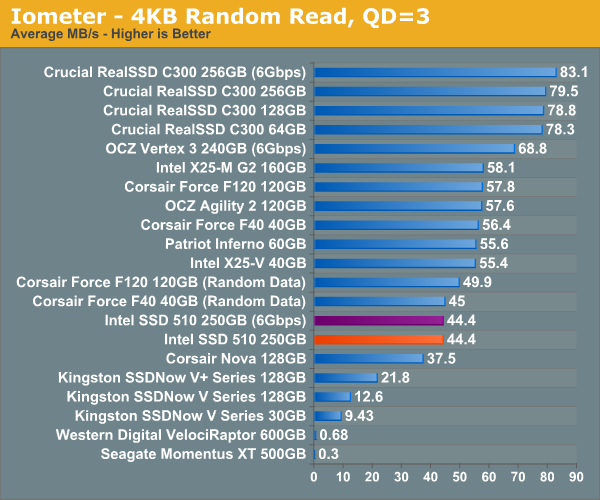The Intel SSD 510 Review
by Anand Lal Shimpi on March 2, 2011 1:23 AM EST- Posted in
- IT Computing
- Storage
- SSDs
- Intel
- Intel SSD 510
Random Read/Write Speed
The four corners of SSD performance are as follows: random read, random write, sequential read and sequential write speed. Random accesses are generally small in size, while sequential accesses tend to be larger and thus we have the four Iometer tests we use in all of our reviews.
Our first test writes 4KB in a completely random pattern over an 8GB space of the drive to simulate the sort of random access that you'd see on an OS drive (even this is more stressful than a normal desktop user would see). I perform three concurrent IOs and run the test for 3 minutes. The results reported are in average MB/s over the entire time. We use both standard pseudo randomly generated data for each write as well as fully random data to show you both the maximum and minimum performance offered by SandForce based drives in these tests. The average performance of SF drives will likely be somewhere in between the two values for each drive you see in the graphs. For an understanding of why this matters, read our original SandForce article.

It's a bit unfortunate for Intel that we happen to start our performance analysis with a 4KB random write test in Iometer. The 510's random write performance is only marginally better than the X25-M G2 at 49.7MB/s. The RealSSD C300 is faster, not to mention the SF-1200 based Corsair Force F120 and the SF-2200 based OCZ Vertex 3.
Although not depicted here, max write latency is significantly reduced compared to the X25-M G2. While the G2 would occasionally hit a ~900ms write operation, the 510 keeps the worst case latency to below 400ms. The Vertex 3 by comparison has a max write latency of anywhere from 60ms - 350ms depending on the type of data being written.
Many of you have asked for random write performance at higher queue depths. What I have below is our 4KB random write test performed at a queue depth of 32 instead of 3. While the vast majority of desktop usage models experience queue depths of 0 - 5, higher depths are possible in heavy I/O (and multi-user) workloads:

While the X25-M G2 scaled with queue depth in our random write test, the 510 does not. It looks like 50MB/s is the absolute highest performance we'll see for constrained 4KB random writes. Note that these numbers are for 4KB aligned transfers, performance actually drops down to ~40MB/s if you perform sector aligned transfers (e.g. performance under Windows XP).

Random read performance is just as disappointing. The X25-M G2 took random read performance seriously but the 510 is less than 20% faster than the Indilinx based Corsair Nova. When I said the Intel SSD 510's random performance is decidedly last-generation, I meant it.










128 Comments
View All Comments
Anand Lal Shimpi - Wednesday, March 2, 2011 - link
Correct me if I'm wrong, but I believe everything regarding the 25nm issue has been resolved? OCZ has initiated an exchange program and is covering all associated costs for users that were affected.I'm still curious to look into the behavior of 25nm NAND however by the time I got back from MWC it looks like the bulk of what needed to happen regarding the 25nm issue already happened.
Is there a remaining aspect of the issue that hasn't been addressed that you'd like me to pursue?
Take care,
Anand
semo - Wednesday, March 2, 2011 - link
Hi Anand,Thanks for replying. Just to be clear, what I've been expecting is for you to write a news item or an article about OCZ and 25nm SSDs. It seems you thought I was asking for you fix the problem (it is not your problem and it isn't you who was supposed to fix it).
I still don't understand why all the review sites were silent even after the OCZ 25nm drives hit retail. Was I the only one excited about the new NAND flash tech, and itching to read an in depth review/analysis. Some time passed and some people started complaining that their 25nm V2s were somewhat slower than what reviews (and the packaging) were promising…still no in depth look at 25nm tech at that point.
The jmicron issue was resolved eventually as well but there were a lot of articles written about it.
I’m still stumped as to how hard it is to find a proper review about the 1st ever consumer 25nm SSD to hit retail (the OCZ V2).
m.amitava - Wednesday, March 2, 2011 - link
I am sure Anand has quite a lot of pull with OCZ and I believe users who have been stranded with 25nm drives will thank him for investing his time in sorting out the issue rather than writing on it....would like to hear your POV though Anand, so far you haven't given us your take on it....
FunBunny2 - Thursday, March 3, 2011 - link
-- Is there a remaining aspect of the issue that hasn't been addressed that you'd like me to pursue?Absolutely!!! Not so much the OCZ nonsense, but rather the impact we can expect on SSD acceptance and viability with 25nm parts. IIRC, IMFT NAND at 25nm has/will have ECC on die to deal with some of the issue.
What's not clear is whether an SSD can be built at 25nm that ends up being as "good" as one at 32/34nm at the same price point. We may have hit a corner case in Moore's Law: the reduction in price at 25nm may not be sufficient to overcome both the erasure and electrical issues which present at 25nm. The OCZ fix was to replace larger die with smaller die to get back channels. That's gotta hurt the profit equation. And this doesn't fix the erasure issue.
In other words, there's a whole lot to be delved into with regard to 25nm impact on SSD. A whole lot.
semo - Friday, March 4, 2011 - link
"Correct me if I'm wrong, but I believe everything regarding the 25nm issue has been resolved?"I've just done a quick search on newegg for a Vertex 2 and I still can't figure out at a glance which are the nerfed 25nm drives and which aren't. So the bait-and-switch games is still on as far as I can tell.
Anand Lal Shimpi - Wednesday, March 2, 2011 - link
It really boils down to the performance vs. reliability debate. The Vertex 3 is overall a faster drive (assuming you're not doing much in the way of incompressible writes), however it's unclear how much OCZ and SF have improved their reliability testing and validation. If the 510 is close enough in performance and can boast the same sort of reliability that the original X25-M did, then it may be a viable alternative for some users who aren't as interested in absolute performance but want a product that has gone through Intel's validation/testing.With the X25-M the performance gap was too great to really value the drive over the SF-1200 based offerings. The 510 is much more competitive, although our recommendation for pure performance is still obviously the Vertex 3.
As I mentioned in the conclusion, if OCZ can ramp and ship the Vertex 3 with a better reliability track record than the Vertex 2 (not that the latter was bad, it just wasn't quite as good as the X25-M) then this becomes a non-issue. The way I see it is this: the 510 pressures OCZ to work on validation and QA testing, while the Vertex 3 forces Intel to take performance much more seriously. Both are very important to have in the market.
Take care,
Anand
lyeoh - Wednesday, March 2, 2011 - link
Hi Anand, have you noticed any issues with hibernate for SSDs? Being able to hibernate is rather important for many mobile users.There are some people complaining that hibernate stopped working when they switched to their SSD drive, whereas others say they don't have probs.
As for reliability, how much more reliable are Intel really anyway? They did have problems with their previous drives too.
epicsnackus - Wednesday, March 2, 2011 - link
I have hibernated my laptop with Intel G2 160GB drive every day for more than a year, with no issuejimhsu - Wednesday, March 2, 2011 - link
I do have an issue with sleep though on an Intel SSD. On resume after sleep, the drive errors with KERNEL_NONPAGED bluescreens. Does not occur with hibernate. Any idea what is going on?aarste - Wednesday, March 2, 2011 - link
Not tried Hibernate, but sleep is working fine on my Intel X-25M 80GB (I put the PC to sleep every night), so the BSOD may be something else entirely.